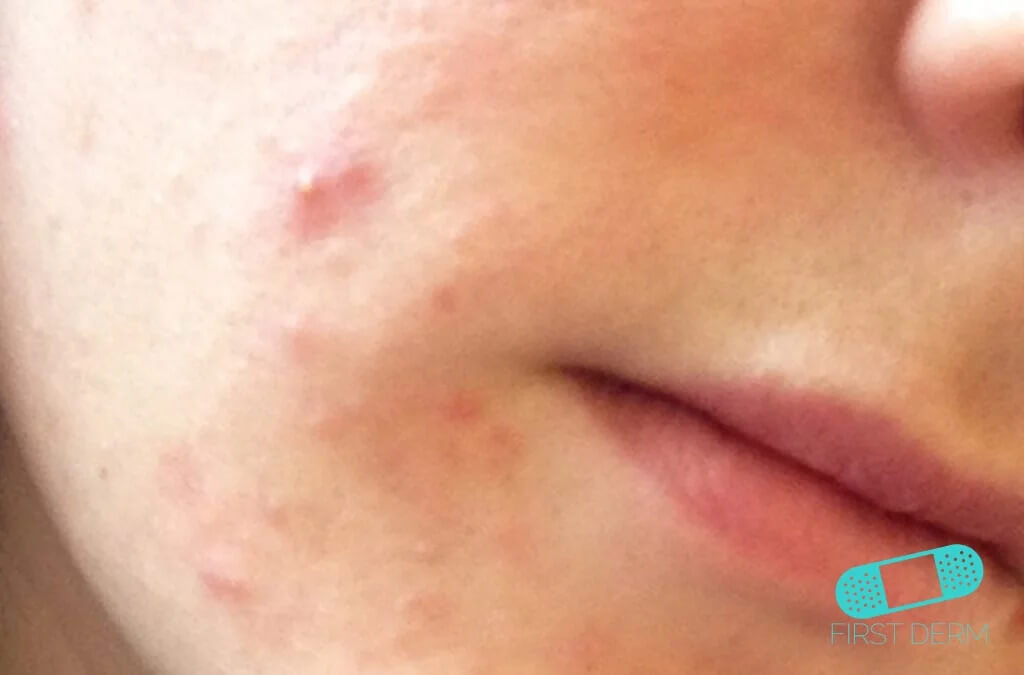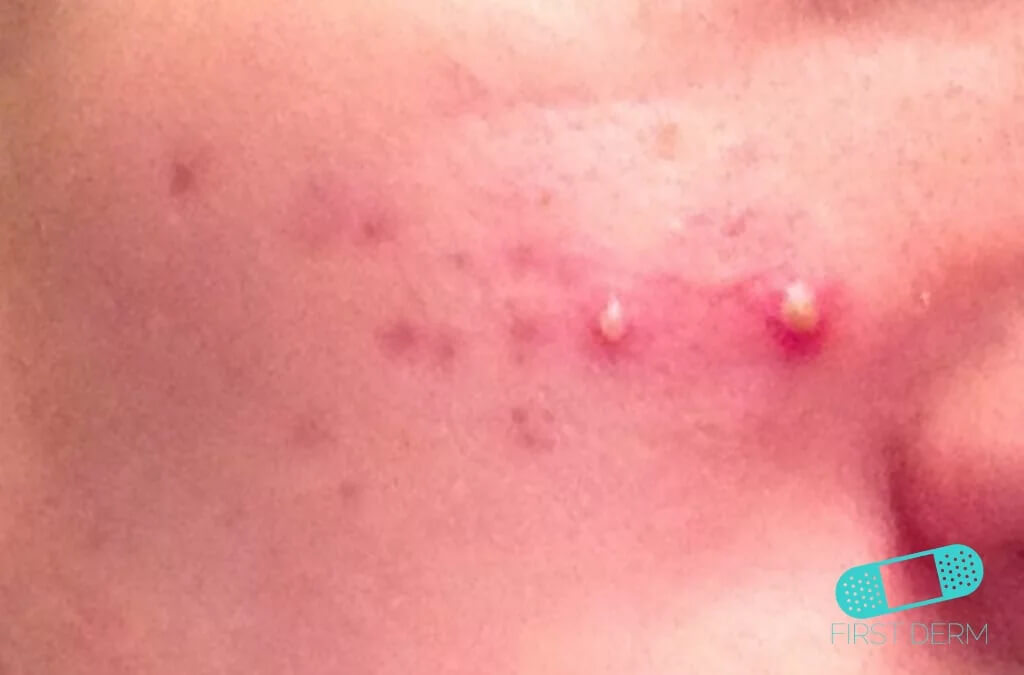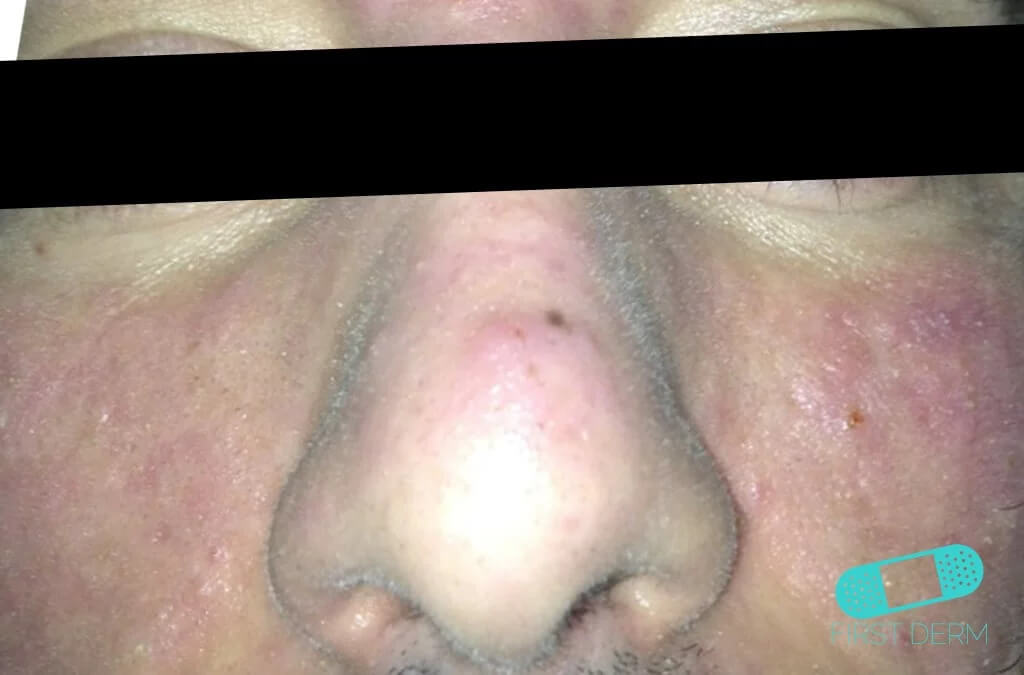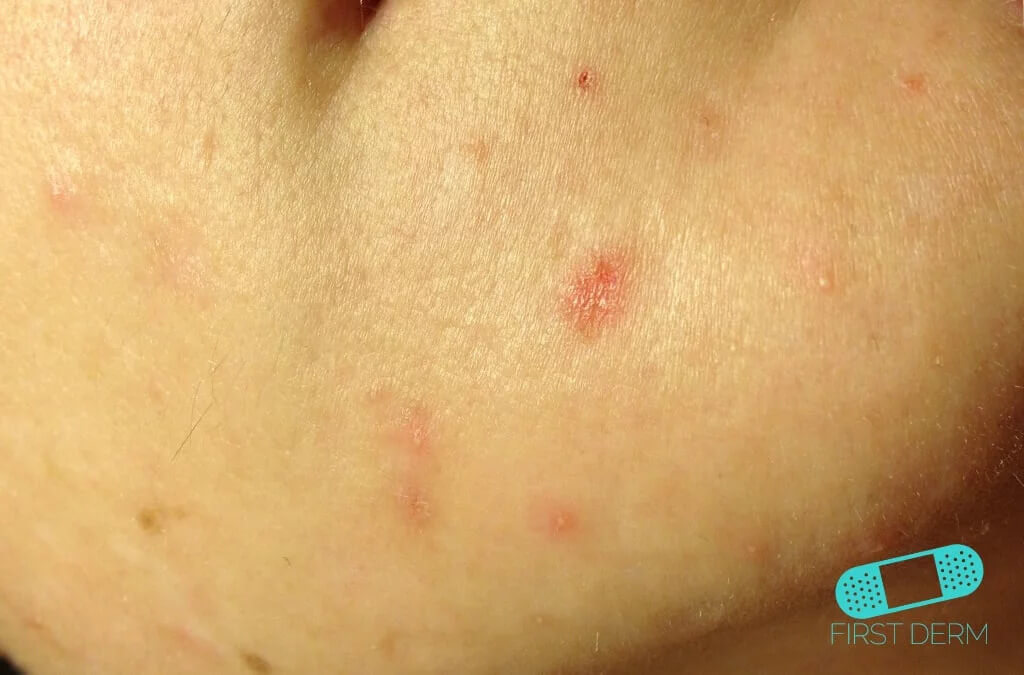Acne Scars
Medically reviewed by The Dermatologists and written by Dr. Aayushi Shah
Acne scars occur as a sequalae of acne
- Can affect quality of life
- At home remedies do not work
- Early treatment of acne may be preventive
- Various surgical procedures, peels, and lasers form the mainstay of treatment
Related Blog Posts:
Acne occurs due to inflammation and blockage around the hair follicles and oil glands in the skin. The inflammation may lead to pus formation around the hair follicles, and ultimately a rupture of the follicles. This in turn stimulates the wound healing process, which eventually ends in scar formation.

Image of a person’s chin affected by acne vulgaris, showing red, inflamed pimples. The skin texture appears irritated and slightly swollen, typical of acne vulgaris symptoms.
While most people are affected by acne at some point in their lives, those suffering from severe acne often have acne scars even after resolution of the active acne. The psychological effects of acne scarring can be diverse, and can severely affect the quality of life in affected individuals.
Acne scarring is seen much more frequently in cases with severe variants of acne such as nodulocystic acne, acne fulminans, or acne conglobata.

Person’s face with small, whiteheads, characterized by closed comedones. The skin shows small, raised bumps that are white or skin-colored, indicating clogged hair follicles that haven’t opened. The overall skin texture appears relatively smooth, aside from these distinct whiteheads.
Treatment of active acne, when initiated at the right stage and continued for the required duration, can reduce the occurrence of acne scarring. However, once scars are established, they usually require some interventions such as dermato surgical procedures or lasers, to treat them and reduce the appearance.

Image of a person’s face affected by acne vulgaris, showing numerous blackheads. These blackheads are open comedones visible at the surface of the skin, filled with excess oil and dead skin cells, giving them a distinctive black appearance due to the irregular light reflection from the clogged hair follicles.
The treatment of acne also relates to these three causative factors. Topical retinoids like Retin-A (tretinoin) and oral retinoids like Accutane (isotretinoin) help with skin maturation. Antibiotics like doxycycline and minocycline pills and clindmaycin lotion help with the infectious component, as do washes like benzoyl peroxide. Birth control pills can help with the hormonal component.
Based on the severity and type of acne, you may be treated with topical medications alone or a combination of topical and oral medications. The most effective medication for acne is Accutane (isotretinoin) and eliminates acne for almost everyone, but requires extensive laboratory monitoring and diligent efforts to prevent pregnancy due to possible birth defects while on this medication.
Consult an online dermatologist today and get an answer on your skin concern within hours.
Why do acne scars occur?
Acne scars are a result of the body’s healing process. The inflammation seen in acne causes a destruction of the skin and hair follicles along with collagen and other surrounding structures. Once the inflammation subsides, the skin tries to repair itself, however, this process leads to scar formation. A scar, by definition, is the development of fibrous connective tissue in the skin at a site of previous damage or injury.
Types of Acne Scars
Atrophic acne scars – Atrophic acne scars are those scars where the tissue under the skin (subdermis) has been destroyed (atrophy). Atrophic acne scarring is the most common type of acne scarring, seen much more frequently than hypertrophic scars. Atrophic acne scars can be subclassified into the following three types of acne scarring –
1. Rolling Scars – These occur due to tethering of the dermis to the underlying fat laher, giving the skin an overall wavy/uneven/rolling appearance.
2. Icepick Scars – These are narrow (upto 2 mm), punctiform and deep scars. The opening at the skin surface is wider than the deeper infundibulum, thus appearing as a V shape on cross section. The skin looks like it has been pricked multiple times with an icepick, hence the name. These scars are the most difficult to treat.
3. Boxcar scars – These are round or oval scars with well-established vertical edges. Boxcar scars may either be superficial or deep.
Most patients with atrophic scarring will have a mix of all the above scar types, although one type may predominate.
Hypertrophic acne scars – In some patients, acne lesions may heal with hypertrophy of the skin, leading to thickened and elevated scars. These are known as hypertrophic acne scars. They may occur in patients with an underlying genetic tendency for hypertrophic scarring, and are more commonly seen when acne occurs over the trunk rather than on the face.
Consult an online dermatologist today and get an answer on your skin concern within hours.
Grades of Acne Scarring
One of the scales used to grade acne has the following four grades – macular, mild, moderate, and severe.
Grade one, macular, is a scar that’s red but flat.

person’s face with Grade One acne vulgaris, characterized by flat, red macular scars. The skin shows several small, flat red marks, indicative of mild acne scarring without significant raised or pitted areas
Grade two, mild, is a scar that can easily be covered by makeup or facial hair. Grade three, moderate, is “obvious at a social distance.” It is not as easily covered by makeup or facial hair. Finally, grade four, severe, is scarring that is very evident at a social distance greater than 50 centimeters. It is unlikely that facial hair or makeup will completely cover up these scars.
Knowing the severity of your acne scarring will guide the treatment approach.
What to expect from your dermatologist/ health care practitioner?
Your dermatologist can confirm the diagnosis of acne scarring by a visual examination and with the use of a magnifying glass. Further grading of the severity of scarring, as described above, will help to plan the correct treatment approach.
Additionally, your dermatologist may also ask you to take a questionnaire or answer certain questions regarding the impact of acne scarring on your every day life (a quality of life questionnaire). No testing is required to diagnose and treat acne scars.
Consult an online dermatologist today and get an answer on your skin concern within hours.
What can I do?
To reduce your chances of developing acne scars, seek treatment early for your acne. This will prevent occurrence of deeper scars and reduce occurrence of newer acne spots, thus reducing chances of scarring.
Your skin needs to be free from active acne before you can start treatment for the scars, as the treatments may otherwise interfere with each other and the results may not be clearly visible as newer spots and scars keep forming.
Certain over the counter acne creams may help reduce the appearance of scars to a certain extent when used regularly over 3 to 6 months. These creams usually contain retinoids and alpha hydroxy acids, among other ingredients. However, interventional treatments will remain the mainstay to improve scarring, with creams provided very limited benefits.
Should I seek medical advice?
It is better to seek treatment for acne and acne scars at the earliest. Scars cannot be treated by any at-home remedies.
Treatment
The following modalities are useful for treatment of acne scars
- Chemical peels
- Dermabrasion
- Laser resurfacing
- Subscision
- Dermal fillers
- TCA CROSS
Consult an online dermatologist today and get an answer on your skin concern within hours.
Last updated on November 24, 2023
Source
Sutaria AH, Masood S, Saleh HM, et al. Acne Vulgaris. In: StatPearls [Internet]. Treasure Island (FL): StatPearls Publishing; 2023. Updated 2023 Aug 17. Available from: https://www.ncbi.nlm.nih.gov/books/NBK459173/.
National Library of Medicine (US). Acne. In: MedlinePlus [Internet]. Bethesda (MD): National Library of Medicine (US); Available from: https://medlineplus.gov/acne.html
American Academy of Dermatology Association. Acne: Overview. In: American Academy of Dermatology Association [Internet]. Available from: https://www.aad.org/public/diseases/acne/really-acne/.
Ask a Dermatologist
Anonymous, fast and secure!

Dr Aayushi Shah is a practising dermatologist from India, currently based in the UK. She has 5 publications has authored chapters covering a wide range of topics, including chronic urticaria, psoriasis, and skin moisturisers. She also works as a Medical Editor, and enjoys blogging in her free time.

